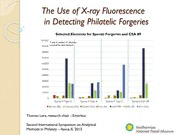
Preview lera
The Use of X-ray Fluorescence in Detecting Philatelic Forgeries Selected Elements for Sperati Forgeries and CSA #9 1000000 Y-axis is number of photons counted for eachelement 900000 800000 700000 600000 500000 400000 300000 200000 100000 0 Sperati 9 Type A Sperati 9 Type B Sperati 9 Type C Genuine CSA #9 Barium (Ba) Calicum (Ca) Cobalt (Co) Iron (Fe) Lead (Pb) Sulfur (S) Zinc (Zn) Thomas Lera, research chair - Emeritus Second International Symposium on Analytical Methods in Philately – Itasca, IL 2015 NPM Scientific Laboratory 1600x Leica Microscope VSC 6000 Micrometer XRF FTIR How it Works Light hits the things you see, and is absorbed at certain energies based on molecular structure of the thing in question, and your eye is the detector for those energy ranges! FTIR VSC 6000 XRF 3 How it Works – XRF (x-ray fluorescence) We see color because our eyes are excellent detectors of 1-3 eV photons. • Atoms and molecules can absorb light (= energy). To understand how, let’s think on the level of one single atom, which is made up of neutrons, protons (in the nucleus) and electrons (in orbit around the nucleus). How many of each of these there are in an atom determines what element that atom is. • Electrons are bound to the nucleus at of any particular atom at specific energies, which are unique to each element. Think of it as gravity. The nucleus is like a planet, and depending on the “size” (energy) of a nucleus, it can hold “moons” (electrons) in various “orbits” (energy levels, binding energies) around it at specific distances. • When a beam of light hits the atom, some photons from that beam of light have just the right amount to knock the electrons out of it’s orbit. The binding energy of that electron is joined by the energy of the photon that knocked it from it’s orbit, that is, the photon is absorbed. • The energies which are not absorbed are reflected, and therefore detected by your eye. In other words, something that appears blue absorbs all photons other than those that have an energy of approximately 3eV. Only the light waves that appear as the observed color are reflected back to your eye, and the others are absorbed. • This pattern of absorptions (or emissions) is unique to each element, molecule, etc. How It Works - XRF Very sensitive elemental analysis by anyone in seconds anywhere The principles of XRF—and its uses in measurement—are based entirely in photon-electron interactions. The XRF instrument is, in essence, an expensive flashlight! The signal passes from the instrument’s detector, to the digital pulse processor, to the CPU where the data is transformed from counts per channel, to spectra and quantitative chemistries in seconds with no sampling. How it Works – XRF (x-ray fluorescence) When the switch is pulled, activating the Analyzer’s x-ray tube, the x-rays strike the inner shell electron of the atoms in the sample and it is ejected from the atom.* * X-ray energy must be higher than absorption edge of the element. 6 How it Works – XRF (x-ray fluorescence) Next, an electron from an outer shell moves to fill the vacancy in the inner shell. 7 How it Works – XRF (x-ray fluorescence) An X-ray photon is released and hits the analyzer’s detector. (This photon’s energy is unique to the element it came from-- e.g., Aluminum K-shell energy is 1.47 keV) 8 Each Element has its Own Signature Energy for K and L-Shell Electrons K-shell Aluminum 1.48 keV K-shell Iron (Fe) 6.40 keV Each Element has its Own Signature Energy for K and L-Shell Electrons Fe – Ka 6.403 keV Al – Ka 1.48 keV
